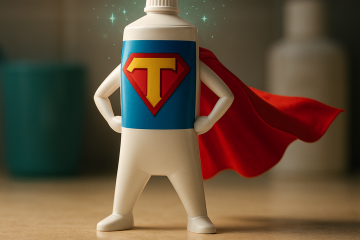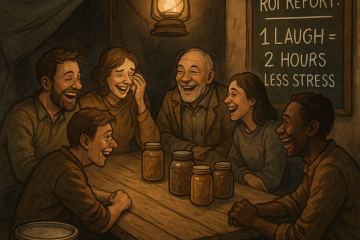
Practice the art of being still
You know what’s more terrifying than a natural disaster?
A grown man who can’t sit still for five minutes without a screen, snack, or sarcastic comment. (And yes, Steve, I’m looking at you.)
We live in a world where “stillness” is practically a four-letter word. If you’re not multitasking, doomscrolling, or listening to a podcast while cleaning the kitchen with one hand and texting your group chat with the other, are you even alive?! But here’s the kicker: in an emergency—or honestly, in life—your ability to sit still, listen carefully, and not panic might be your most valuable survival skill.
Picture This:
You’re in a shelter-in-place situation. The power’s out. Cell towers are down. You’ve got two candles, one dog, three toddlers, and no Wi-Fi. Suddenly, your cousin Eddie decides this is the perfect time to practice his harmonica. The youngest is trying to climb the curtains. And someone keeps asking, “Is this like the apocalypse or just a drill?” Meanwhile, all you need to do is wait quietly until the storm passes or help arrives.
But nobody—nobody—knows how to just sit.
That’s the problem. Stillness, the art of controlled inactivity, has gone the way of cursive handwriting and rotary phones. We’ve trained our bodies and brains to equate stillness with boredom and boredom with doom. But in survival, boredom is a luxury. It means you’re not actively dodging danger. It means you have time to think. And friend, thinking is how people make smart choices—like not trying to “go check on things” in the middle of a hurricane.
Boredom Builds Bravery (Yes, Really)
When you’re still, your brain does weird and wonderful things. It problem-solves. It calms down. It remembers that you packed beef jerky and that the emergency crank radio is in the garage. Stillness gives your logic time to catch up with your adrenaline.
On the other hand, panic is impatient. Panic wants action—any action. It tells you to do something, even if that something is totally dumb, like lighting a candle next to your backup fuel supply.
So, what if we taught our families to get good at boredom? To sit with their thoughts without immediately reaching for a distraction? What if we taught our kids (and the adults who act like kids) that silence isn’t punishment, it’s practice?
How to Train for Stillness (Without Losing Your Sanity)

Train your family to be STILL.
-
Start with a Stillness Challenge:
Set a timer for 5 minutes. Everyone sits still. No phones. No talking. Just breathing. Yes, it’s awkward at first. That’s the point. Awkward grows into awareness, which grows into calm. -
Make It a Game for Kids:
Call it “Ninja Listening Time” or “Statue Survival Skills.” Kids will rise to the occasion if you give stillness a sense of mission. Bonus: it helps them learn how to self-regulate, which means fewer public meltdowns when the juice box is warm. -
Reward Calmness, Not Just Action:
In our go-go-go culture, we love doers. But in prepping? The listener, the observer, the one who notices that the wind has changed or the animal sounds have stopped—they’re the MVP. -
Use Stillness as a Family Ritual:
After dinner, turn everything off. No TV. No music. No chatter. Just sit on the porch, or around a candle, or near the fireplace and be. It feels weird. Then it feels lovely. Then you’ll realize you missed it.
Stillness isn’t laziness. It’s wisdom with the brakes on.
It’s the ability to observe without reacting, to breathe through uncertainty, to endure discomfort without filling the silence with fluff. Stillness is a self-reliance skill that looks passive, but builds strength the way sleep builds muscle.
If you want to raise strong kids, be a wise spouse, or just survive a blackout without eating all your chocolate reserves out of sheer nerves—learn to sit still. Practice it like your life depends on it. Because someday?
It just might.


